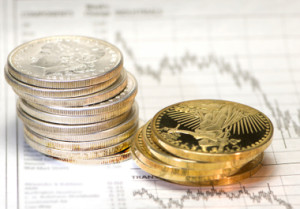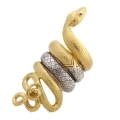 Everyone knows that gold (COMEX:GCZ13) and silver (COMEX:SIZ13) have value, but few people understand their real value. Some people say that the current price of gold and silver is too high after rising 12 years. Is that true? If we know the real value of gold and silver, we will have a clear answer to the question. In this article, I will decode the three main components of the value of gold and silver: Monetary value, commercial value and cultural value. Then we will know if it is worth to buy gold and silver at the current price and what to buy. This article is for all people no matter whether you own gold and silver or not.
Everyone knows that gold (COMEX:GCZ13) and silver (COMEX:SIZ13) have value, but few people understand their real value. Some people say that the current price of gold and silver is too high after rising 12 years. Is that true? If we know the real value of gold and silver, we will have a clear answer to the question. In this article, I will decode the three main components of the value of gold and silver: Monetary value, commercial value and cultural value. Then we will know if it is worth to buy gold and silver at the current price and what to buy. This article is for all people no matter whether you own gold and silver or not.
1. Gold and silver have monetary value
The principle to estimate the monetary value of gold and silver is based on the fact that gold and silver are money. Many people account paper currency as money. That is wrong. Paper currency is just a kind of fiat currency. “The average life expectancy for a fiat currency is twenty-seven years” (Chris Mack, president of Trade Placer). Gold and silver are real money and have been used as money for 5,000 years by all countries. You can easily learn the difference between money and currency on the internet. I don’t need to reiterate here. Just remember that a currency loses its purchasing power as the currency issuer, the central bank, prints more currency. But money (such as gold and silver) will never lose its purchasing power though it may fluctuate during some short periods. No one can print one ounce of gold or silver.
The method to estimate gold’s monetary value in a specific currency is that the money supply should be backed by the total gold reserve in that country. There is money supply data such as monetary base, M1, M2, M3 and gold reserve data such as central bank gold reserve, private gold reserve, tradable gold, aboveground gold and underground gold. Different money supply data should be paired to different gold reserve data (monetary base and central bank gold reserves are a pair, aboveground gold and M2 are another pair). The results derived by different pairs should be coincident or approximately the same value. I will use the monetary base and the gold reserve by the Fed as an example to estimate gold’s monetary value in USD. We know that the Fed reserves 261 million ounces of gold (World Gold Council) and the current monetary base is $3,398,930 millions in August, 2013 (FED). Therefore, the gold’s monetary value is $13,022 / ounce (3,398,930 / 261). There are some countries such as China and Canada who don’t have enough gold reserve at present to back their currencies. For those countries, we use the global total monetary base and total gold reserve by all central banks to estimate gold’s monetary value as a reference. Fortunately, the result is almost the same as the value we got in the USA. It is about 80,000 yuan / ounce in RMB or $13,000 / ounce in CAD.
Regarding silver’s monetary value, the result is terribly high, which few people can accept it today if we use the silver reserve to divide the monetary base. The reason why silver’s monetary value is higher than gold’s monetary value is that silver is rarer than gold for almost all kinds of reserve data. According to Silver Institute and CPM Group, current government stocks of silver are close to zero compared to 350 million ounces in 1970, more than 95% of silver dug by human beings has been consumed by industry. However, we can estimate silver’s monetary value with an alternative method by dividing gold’s monetary value by gold silver price ratio (GSPR). In another paper, The Beginning of the Silver Age, I discussed GSPR and suggest that it will reach the area between 9 and 16 in about five to ten years and will continue to go down in the long term. Let’s use the medium number of 12.5 as a possible GSPR, we can get the current monetary value of silver as $1,041 / ounce in USD and as 6,400 yuan / ounce in RMB.
2. Gold and silver have commercial and cultural value
The cultural value of gold and silver is really difficult to estimate because people with different cultures have different value standards. In addition, some items have added value beyond the materials. For example, a gold dish or chair used by a king or a hierarch, an amulet given by a relative, ancient silver coins and so on, all of them have added value and the value is hard to estimate. The commercial value of gold and silver is mainly decided by their supply and demand. It’s also hard to estimate the exact value. To make it easy, I will use statistical methods with historical data spanning 70 years to estimate the gold’s commercial and cultural value (GCCV) together in terms of monetary value.
Using the historic data of monetary base and gold reserve in the United States, we can calculate gold’s monetary value in USD during the last 70 years after Bretton Wood System (July, 1944). Then we divide gold price by monetary value to get a chart of the ratio of price to monetary value of gold (RPMV-Gold) in the United States over the last 70 years as in Figure 1.

From figure 1, we can see that RPMV-Gold reached 170% in 1980. Most people in North America and west Europe then expected gold would be money again soon. The 70% more above its monetary value was the maximum RPMV-Gold. We also see that RPMV-Gold reached the bottom around 10% three times in 1999, 2008 and 2013. Few people in the world these days think that gold will be money again thanks to the government education all over the world. Now we have a range of GCCV from 10% to 70% of gold’s monetary value. With the same principle, we can figure out the range of silver’s commercial and cultural value (SCCV), it was between 2% and 60% of silver’s monetary value during the last 70 years. The ratio of price to monetary value of silver (RPMV-Silver) will be much higher than 60% in the future because of the coming silver shortage.
Read the full article at FuturesMag






